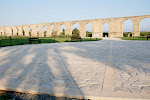Showing posts with label Archaeological sites. Show all posts
Showing posts with label Archaeological sites. Show all posts
Tuesday, November 4, 2008
The Larnaca Castle
At the end of Athens Avenue, you cannot miss the Larnaka Castle. The Byzantines founded a first fortification on the spot in the 12th century. But, the first written source about the castle is of the 14th century. Chronographer Florius Boustronius dates it during the years of Luzignian King James I (1382-1398AD), who built it to protect the harbor of the town. It is the time that the Genovese occupied Famagusta and the Luzignians had to develop another major port for the needs of their kingdom. It is recorded in 18th century sources that the castle was built by the Turks in 1625 AD, since it was in a semi-ruinous state at that time, even though a Turkish garrison was maintained there since 1570 AD. The English used it as a prison and place for execution of death convicts up to 1948.
Pambula and the ancient port (700BC – 300AD)
Behind the Larnaka District Museum on the Pambula hill, which is secluded by Kilkis and Kimonos Streets, excavations started in the 1930’s. Temples of Hercules and Aphrodite were firstly uncovered. In the 1970’s a French archaeological mission excavates every year the site as great discoveries were made here. The greatest is the ancient port of the city Kingdom of the classical years, which was found almost intact. This port is in a better condition that any other ancient man-made port ever discovered. Visits at the site are allowed only after permission of the Director of the Larnaka District Museum.
Prehistoric site near Hala Sultan Tekke
The largest prehistoric town of Cyprus was uncovered near the Hala Sultan Teke
by a Swedish archaeological mission. This discovery was made in the late 1970’s
and the excavations continued till the 1990’s. This prehistoric town had its port in
the central salt lake as it was then open to sea. The town lived from about
1700 BC to 1000 BC. The rich finds are displayed in the Nicosia and
Larnaka District Museums, but the site displays some very interesting stone built
wells and toilets, which are within the private houses of this advanced for its
times town. Visits are allowed only after an approval by the Director of the
Larnaka District Museum.
by a Swedish archaeological mission. This discovery was made in the late 1970’s
and the excavations continued till the 1990’s. This prehistoric town had its port in
the central salt lake as it was then open to sea. The town lived from about
1700 BC to 1000 BC. The rich finds are displayed in the Nicosia and
Larnaka District Museums, but the site displays some very interesting stone built
wells and toilets, which are within the private houses of this advanced for its
times town. Visits are allowed only after an approval by the Director of the
Larnaka District Museum.
Ancient Kition (kathari)
This archaeological site on Pasicratous Street is one of the first sites that the Cyprus Department of Antiquities excavated after independence in the early 1960’s. It is here that it was clearly found that the Mycenaean Greeks arrived in Larnaka in the 13th century BC and the Phoenicians in the 9th. The site is the Temple area of the ancient city Kingdom of Kition. In the same area exist Egyptian style Temples of the 18th Egyptian Dynasty, which are older than the Greek and served the eteocypriot (pre-Hellenic) population. Besides the Temples the archaeologists uncovered here the history of the cyclopean walls and the history of the copper metallurgy of the town. The site can be visited on a daily basis during working hours and the most interesting architectural remains are those of the Temple of Aphrodite – Astarte built by the same Phoenician masonry that built the Temple of Solomon in Jerusalem the same period (9th century BC).
Subscribe to:
Posts (Atom)







